
In support of the cause of climate change mitigation, a Philippine team will join the World Solar Challenge, a friendly competition where cars, powered only by solar and kinetic energy, race from Darwin to Adelaide from 16 – 22 October 2011.
The Challenge’s main objective is to draw attention to the imperatives of sustainable transport – like solar and electric-powered vehicles – in response to global climate change. The event is one of the most prestigious of its kind, and attracts the best technical universities and colleges worldwide.
Contestants in the World Solar Challenge undertake a roughly 3,000 kilometre journey, commencing at 8:30am on 16 October at the Darwin Town Hall. Once the teams leave Darwin via the Stuart Highway, they must travel as far as they can until 5 p.m., and then camp out in the desert.
During the journey, there will be seven 30-minute mandatory check points (usually at Katherine, Alice Springs, Dunmarra, Tenant Creek, Coober Pedy, Glendambo and Port Augusta however this is still subject to change depending on the organizers’ final decision), where team managers may update themselves on the weather and their own positions in the field.
The finish line is at Victoria Square in Adelaide.
A Philippine team first joined the event in 2007.
This year’s Philippine team, dubbed “Sikat II,” will consist of 13 members.
Sikat II was designed and created by 22 engineering students and seven faculty members of the Mechanical Engineering, and Electronics and Communications Engineering Departments of De La Salle University-Manila. Leading the project are Dr. Pag-Asa Gaspillo and Professor Jose Antonio Catalan, with the support of team heads Martin Kalaw and Isidro Marfori III.
Sikat II sports a sleek and aerodynamic body made of lightweight carbon fiber-honeycomb composite. Faster than its predecessors - Sinag and Sikat - Sikat II can run at a top speed of 110kph with its 2-kilowatt motor. It weighs less than 180kg; at least 20 kg lighter than Sikat and at least 110kg lighter than Sinag.
A work of Filipino ingenuity, Sikat II is fueled by solar energy harvested and converted into electricity by photovoltaic cells. It is equipped with Filipino-made solar cells from Sunpower Philippines, a leading manufacturer of high-efficiency solar cells in the world, based in Laguna.
With its much-improved solar technology, Sikat II hopes to finish the 3,000-km race in a record-breaking feat this October. In 2007, Sinag (the first Philippine solar car) delivered a remarkable debut performance by finishing 12th among 40 other participants from around the world.
The Sikat II team will be in Darwin a week before the start of the race for pre-event preparations and activities at the Hidden Valley Raceway.
DLSU Professor Catalan told the Embassy of how the Filipinos in Darwin and Adelaide rallied support, some even going out of their way to bring food to the team when the Philippines first joined the challenge in 2007.
For this year’s race, the Philippine Embassy again encourages Filipinos in Darwin and Adelaide to extend a helping hand to the SIKAT II Team by providing moral support and assistance throughout the race.